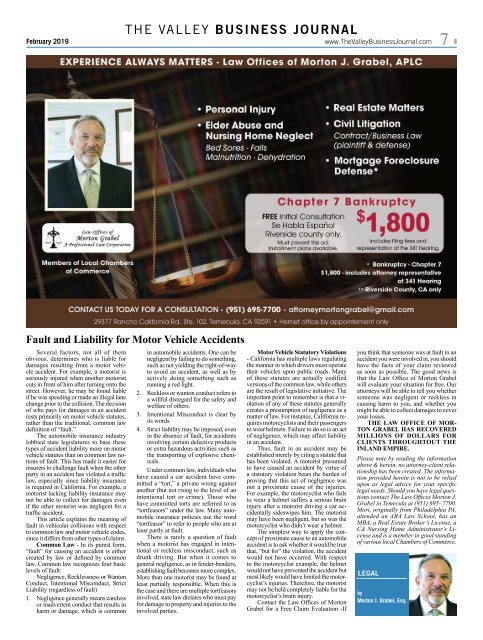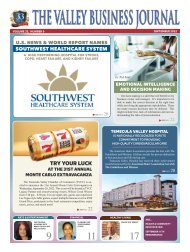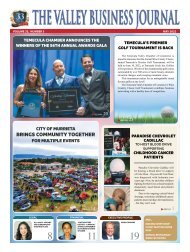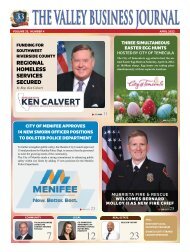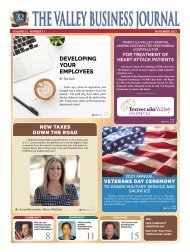VBJ February 19
You also want an ePaper? Increase the reach of your titles
YUMPU automatically turns print PDFs into web optimized ePapers that Google loves.
<strong>February</strong> 20<strong>19</strong><br />
THE VALLEY BUSINESS JOURNAL<br />
www.TheValleyBusinessJournal.com<br />
7<br />
Fault and Liability for Motor Vehicle Accidents<br />
Several factors, not all of them<br />
obvious, determines who is liable for<br />
damages resulting from a motor vehicle<br />
accident. For example, a motorist is<br />
seriously injured when another motorist<br />
cuts in front of him after turning onto the<br />
street. However, he may be found liable<br />
if he was speeding or made an illegal lane<br />
change prior to the collision. The decision<br />
of who pays for damages in an accident<br />
rests primarily on motor vehicle statutes,<br />
rather than the traditional, common law<br />
definition of “fault.”<br />
The automobile insurance industry<br />
lobbied state legislatures to base these<br />
types of accident liability more on motor<br />
vehicle statutes than on common law notions<br />
of fault. This has made it easier for<br />
insurers to challenge fault when the other<br />
party in an accident has violated a traffic<br />
law, especially since liability insurance<br />
is required in California. For example, a<br />
motorist lacking liability insurance may<br />
not be able to collect for damages even<br />
if the other motorist was negligent for a<br />
traffic accident.<br />
This article explains the meaning of<br />
fault in vehicular collisions with respect<br />
to common law and motor vehicle codes,<br />
since it differs from other types of claims.<br />
Common Law - In its purest form,<br />
“fault” for causing an accident is either<br />
created by law or defined by common<br />
law. Common law recognizes four basic<br />
levels of fault:<br />
Negligence, Recklessness or Wanton<br />
Conduct, Intentional Misconduct, Strict<br />
Liability (regardless of fault)<br />
1. Negligence generally means careless<br />
or inadvertent conduct that results in<br />
harm or damage, which is common<br />
in automobile accidents. One can be<br />
negligent by failing to do something,<br />
such as not yielding the right-of-way<br />
to avoid an accident, as well as by<br />
actively doing something such as<br />
running a red light.<br />
2. Reckless or wanton conduct refers to<br />
a willful disregard for the safety and<br />
welfare of others.<br />
3. Intentional Misconduct is clear by<br />
its words<br />
4. Strict liability may be imposed, even<br />
in the absence of fault, for accidents<br />
involving certain defective products<br />
or extra hazardous activities such as<br />
the transporting of explosive chemicals.<br />
Under common law, individuals who<br />
have caused a car accident have committed<br />
a “tort,” a private wrong against<br />
another (but not rising to the level of an<br />
intentional tort or crime). Those who<br />
have committed torts are referred to as<br />
“tortfeasors” under the law. Many automobile<br />
insurance policies use the word<br />
“tortfeasor” to refer to people who are at<br />
least partly at fault.<br />
There is rarely a question of fault<br />
when a motorist has engaged in intentional<br />
or reckless misconduct, such as<br />
drunk driving. But when it comes to<br />
general negligence, as in fender-benders,<br />
establishing fault becomes more complex.<br />
More than one motorist may be found at<br />
least partially responsible. When this is<br />
the case and there are multiple tortfeasors<br />
involved, state law dictates who must pay<br />
for damage to property and injuries to the<br />
involved parties.<br />
Motor Vehicle Statutory Violations<br />
- California has multiple laws regulating<br />
the manner in which drivers must operate<br />
their vehicles upon public roads. Many<br />
of these statutes are actually codified<br />
versions of the common law, while others<br />
are the result of legislative initiative. The<br />
important point to remember is that a violation<br />
of any of these statutes generally<br />
creates a presumption of negligence as a<br />
matter of law. For instance, California requires<br />
motorcyclists and their passengers<br />
to wear helmets. Failure to do so is an act<br />
of negligence, which may affect liability<br />
in an accident.<br />
Thus, fault in an accident may be<br />
established merely by citing a statute that<br />
has been violated. A motorist presumed<br />
to have caused an accident by virtue of<br />
a statutory violation bears the burden of<br />
proving that this act of negligence was<br />
not a proximate cause of the injuries.<br />
For example, the motorcyclist who fails<br />
to wear a helmet suffers a serious brain<br />
injury after a motorist driving a car accidentally<br />
sideswipes him. The motorist<br />
may have been negligent, but so was the<br />
motorcyclist who didn’t wear a helmet.<br />
The simplest way to apply the concept<br />
of proximate cause to an automobile<br />
accident is to ask whether it would be true<br />
that, “but for” the violation, the accident<br />
would not have occurred. With respect<br />
to the motorcyclist example, the helmet<br />
would not have prevented the accident but<br />
most likely would have limited the motorcyclist’s<br />
injuries. Therefore, the motorist<br />
may not be held completely liable for the<br />
motorcyclist’s brain injury.<br />
Contact the Law Offices of Morton<br />
Grabel for a Free Claim Evaluation -If<br />
you think that someone was at fault in an<br />
accident you were involved in, you should<br />
have the facts of your claim reviewed<br />
as soon as possible. The good news is<br />
that the Law Office of Morton Grabel<br />
will evaluate your situation for free. Our<br />
attorneys will be able to tell you whether<br />
someone was negligent or reckless in<br />
causing harm to you, and whether you<br />
might be able to collect damages to cover<br />
your losses.<br />
THE LAW OFFICE OF MOR-<br />
TON GRABEL HAS RECOVERED<br />
MILLIONS OF DOLLARS FOR<br />
CLIENTS THROUGHTOUT THE<br />
INLAND EMPIRE.<br />
Please note by reading the information<br />
above & herein, no attorney-client relationship<br />
has been created. The information<br />
provided herein is not to be relied<br />
upon as legal advice for your specific<br />
legal needs. Should you have legal questions<br />
contact The Law Offices Morton J.<br />
Grabel in Temecula at (951) 695- 7700.<br />
Mort, originally from Philadelphia PA,<br />
attended an ABA Law School, has an<br />
MBA, a Real Estate Broker’s License, a<br />
CA Nursing Home Administrator’s License<br />
and is a member in good standing<br />
of various local Chambers of Commerce.<br />
LEGAL<br />
by<br />
Morton by J. Grabel, Esq.<br />
Steve Fillingim


